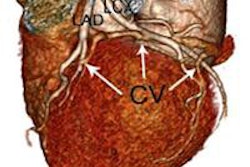Coronary CT angiography (CCTA) is clinically safe and may use medical resources more effectively than conventional methods for evaluating chest pain in patients who are at low or intermediate risk of myocardial infarction (MI), according to research presented earlier this month at the American College of Cardiology (ACC) meeting.
The new results acquired one year after patients were treated confirm 30-day outcomes announced at last year's ACC conference. Based on clinical experience, the randomized, multicenter, rapid rule-out study from the American College of Radiology Imaging Network (ACRIN) established that low- and intermediate-risk patients can be safely discharged after a negative CCTA scan.
Conservative admission protocols that currently govern initial MI diagnosis lead to hospital admissions for six of 10 patients who arrive in the emergency room (ER) with chest pain. Only 5% to 15% are ultimately diagnosed with acute coronary syndrome. The cost of such conservative testing in the U.S. is estimated at up to $10 billion annually.
The new data from the ACRIN PA 4005 trial indicate that 908 patients who underwent CCTA were no more likely to experience a subsequent adverse cardiac event than 462 patients who received traditional care, according to trial co-investigator Dr. Judd Hollander, clinical research director of emergency medicine at the University of Pennsylvania.
Two (0.2%) of the 908 CCTA patients and three (1%) of the 462 traditional care patients died from all causes at the one-year follow-up point. One cardiac death (0.1%) was reported for the CCTA group, with no deaths among traditional care patients.
Acute MI was reported for 11 patients (1%) who received CCTA scans and five patients (1%) who were evaluated with traditional tests. Hollander said that 25 CCTA patients (3%) and seven traditional care patients (2%) underwent revascularization. None of the differences were statistically significant.
"We now know from this study that a negative CCTA, based on 50% maximal stenosis, predicts freedom from [adverse cardiac] events at one year," Hollander said.
Resource utilization
Resource utilization after hospital discharge through the first year was nearly identical for the CCTA and traditional care groups. About 36% of CCTA patients and 38% of traditional care patients had an emergency department visit, and about 16% of CCTA patients and 17% of traditional care patients were admitted to a hospital. Three percent of patients from either group underwent cardiac catheterization.
ACRIN investigators also uncovered differences for year 1 clinical care and medication use by the 35% of patients who had indeterminate findings from traditional testing, compared with the 14% of patients whose conditions were indeterminate by CCTA.
It was unclear if these patients had coronary artery disease (CAD), Hollander said. Physicians had limited guidance for prescribing appropriate care.
"Since there were many more 'no-guidances' in the traditional care group, it is my belief that had we given those doctors guidance, they would have either used more resources like the CAD-positive group or less resources like the CAD-negative group to provide appropriate care," he told AuntMinnie.com.
Frequency rates of additional interventions were as follows.
Intervention frequency at 1 year follow-up: CCTA vs. traditional care
|
Trial subjects were at least 30 years old, with thrombolysis in myocardial infarction (TIMI) scores of 0 to 2 and no ischemia. Patients were randomly selected for CCTA or traditional care after the attending physician determined they would be admitted for observation and objective testing.
"These were not the 35% of patients we normally send home; these are patients we normally admit," Hollander said at the conference.
Hollander emphasized that the research is geared to restrict CCTA use to chest pain patients who actually need it.
"We are trying to avoid making this like a D-dimer or CT for pulmonary embolism, where everyone with symptoms in the ER gets the test," he said.




















